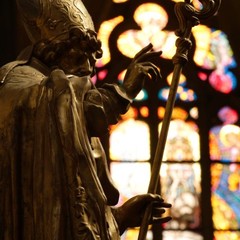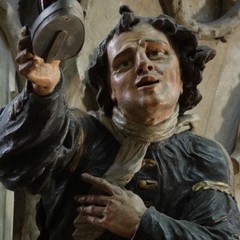St. Vitus Cathedral
Tours for visitors
St. Vitus Cathedral is the largest and the most important temple in Prague. Apart from religious services, coronations of Czech kings and queens also took place here. The cathedral is a place of burial of several patron saints, sovereigns, noblemen and archbishops.

Due to construction work, the free part of the cathedral will not be accessible from 25 October 2023 until further notice. It will only be possible to visit the cathedral with a valid circuit ticket!
Thank you for your understanding.
The cathedral is the third church consecrated to the same saint on the same site. Around the year 925, Prince Wenceslas (Václav) founded a Romanesque rotunda here, which after 1060 was converted into a basilica with three naves and two steeples. The importance of the church grew especially after the establishment of the Prague bishopric in 973 and the founding of the body of canons - the St. Vitus chapter, which later became an important cultural and administrative institution.
In 1344, Charles IV began the construction of a Gothic cathedral. Its first builders, Matthias of Arras and later Peter Parler, built the chancel with a ring of chapels, St. Wenceslas Chapel, the Golden Gate and the lower part of the Great South Tower. It was already Peter Parler who started the construction of the South Tower, however he did not complete it. In the 16th century, is was finished with a Renaissance view gallery and a helmet. Later in the 18th century, the older helmet was replaced by a new dome.
Unfortunately, in 1419 the construction of the Cathedral stopped because of the Hussite Wars. In spite of the endeavours of some sovereigns to secure the continuation of the construction work, the Cathedral remained uncompleted for whole centuries. The facade of the Cathedral was provisionally closed and for example the music choir was bulit.
It was not until the latter half of the 19th century that the Union for the Completion of the Cathedral began the repair of the original part and the completion of the Cathedral in Neo-Gothic style. The church was solemnly consecrated in 1929. Its interior was subjected to adaptations even in later years.
Visitors enter the Cathedral through the portal in the western facade, opposite the passage-way between the Second and Third Courtyard of Prague Castle.
Its bronze door is decorated with reliefs with scenes from the history of the Cathedral and from the legends about St. Wenceslas and St. Adalbert.
The Neo-Gothic part of the Cathedral consists of the main nave and the narrow side aisles, lined with chapels, and the northern wing of the transverse nave. The chapels have stained glass windows. In the cross nave, the ceremonial entrance into the Cathedral can be seen - the Golden Gate - leading to the Third Courtyard.
Situated in the chancel of the Cathedral, in front of the high altar, is the Royal Mausoleum below which there is the royal crypt. The chancel is surrounded by a ring of Gothic chapels. Czech sovereigns and patron saints are interred in some of them.
St. Wenceslas Chapel
St. Wenceslas Chapel is a cult centre of St. Vitus Cathedral. Its magnificent decoration and the different conception of its architecture emphasize its singularity as the central point of the Cathedral with the tomb of the most important Czech patron saint. The facing of the walls, consisting of precious stones, and the wall paintings of the Passion Cycle are parts of the original 14th-century decoration of the chapel. The scenes from the life of St. Wenceslas forming another decorative band are attributed to the workshop of the Master of the Litomerice Altar (the cycle dates back to 1509).
The door in the south-western corner of the chapel leads to the Crown Chamber in which the Bohemian Coronation Jewels are kept.







